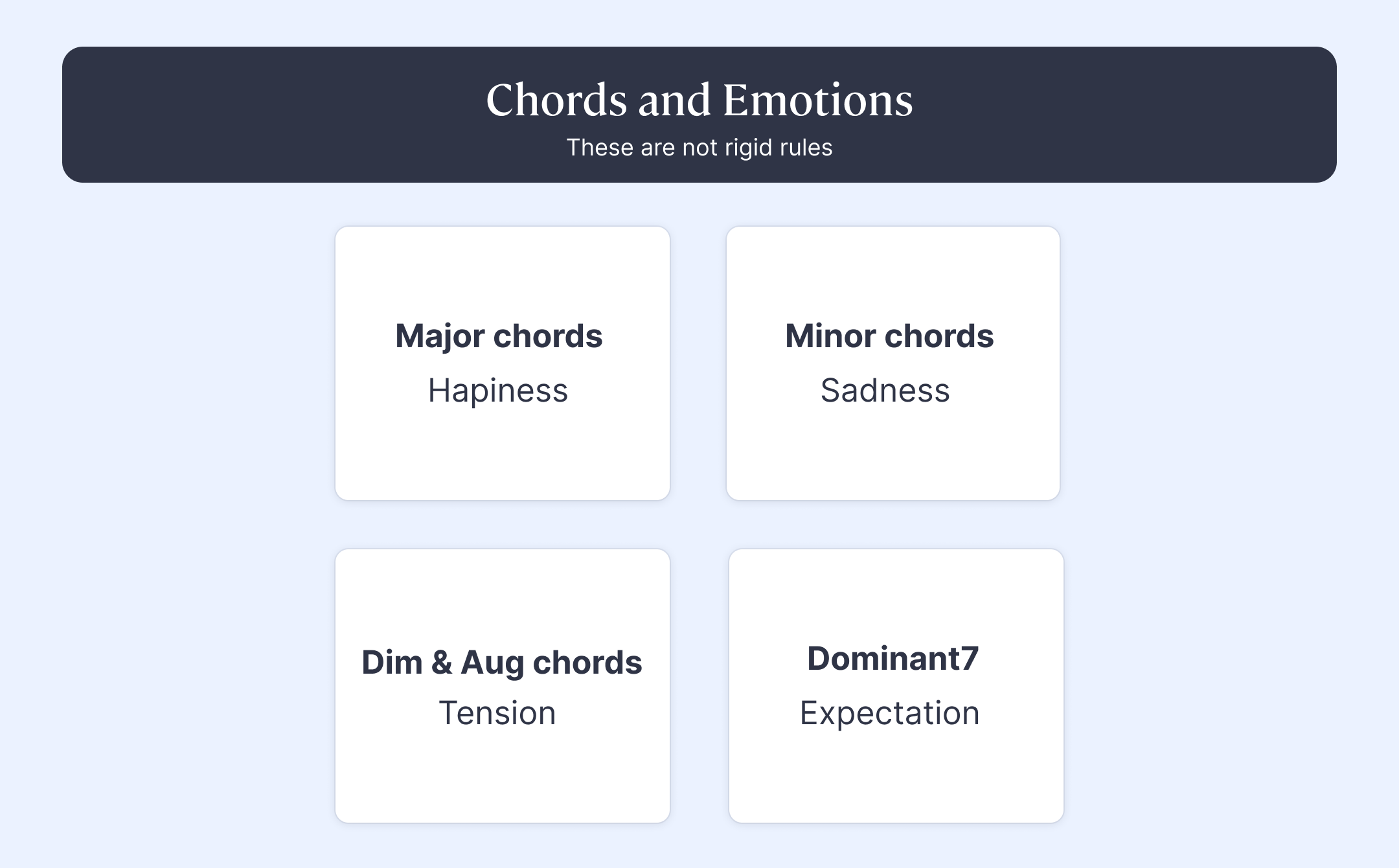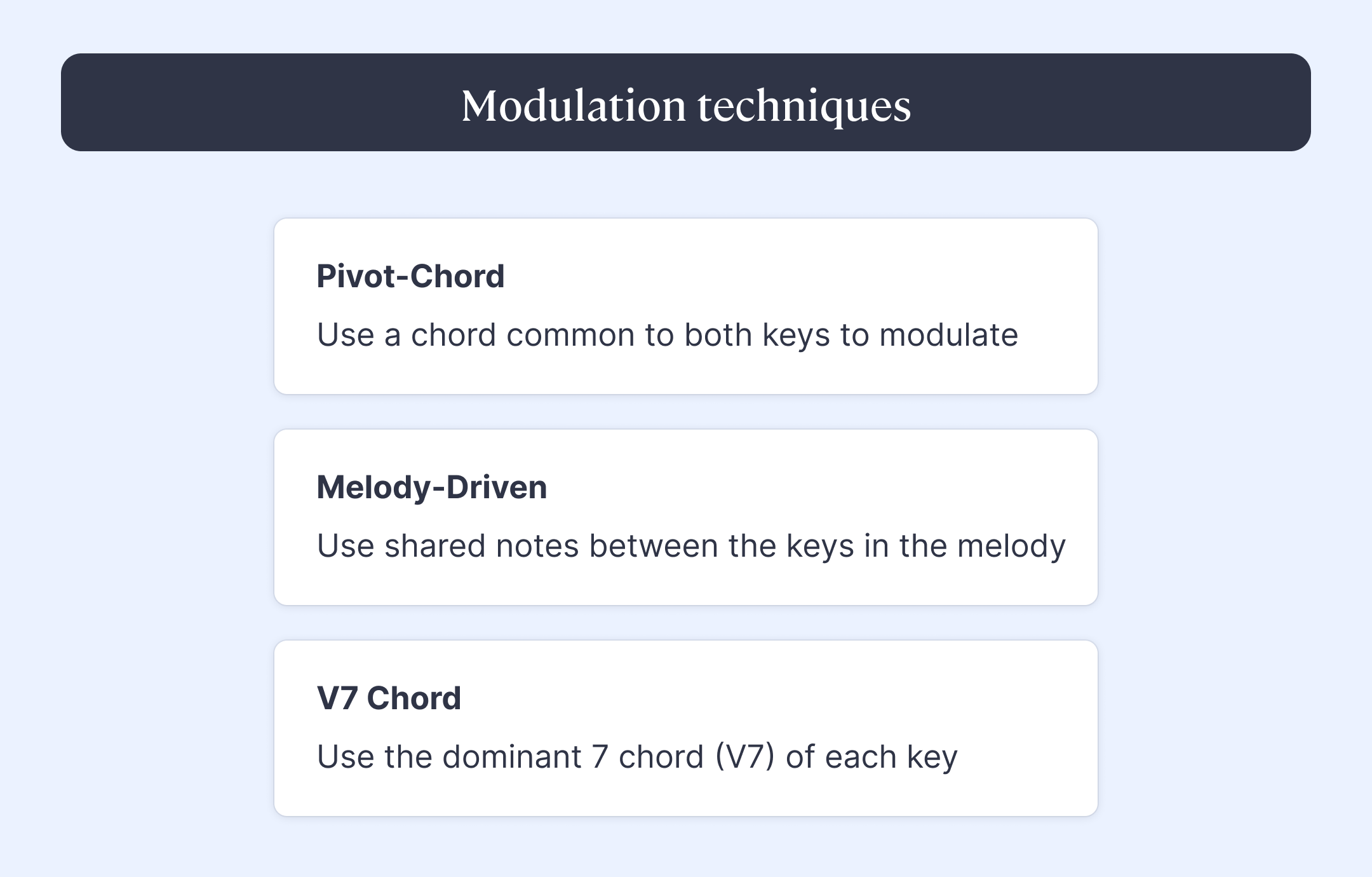Hello, fellow composers on Flat! In this article, we're set to explore the captivating interplay between harmony and emotion in modulation in music. Here, you'll delve into how harmonic choices intricately influence and shape the emotional essence of a piece. Designed for both seasoned composers and avid music lovers, this exploration aims to enrich your understanding of the crucial role that chords and their progressions play in crafting the emotional narrative of a composition.
If you're new to the concept, harmony refers to the simultaneous combination of notes that results in a cohesive and often beautiful sound. It's about the way chords and the progression of chords can bring life and emotional depth to a piece. Harmony is vital in setting the tone of a composition, capable of taking listeners on an emotional journey from uplifting joy to profound melancholy. It provides a backdrop that enhances and complements the melody, adding richness and context to the story being told in your song.
How Modulation in Music Triggers Emotions
Harmony significantly influences our emotions, as demonstrated by scientific research. The detection of dissonance by the inferior colliculus (IC) and its link to emotional reactions showcases harmony's potent impact. Studies have shown that a stronger aversion to dissonance correlates with decreased auditory responses in the IC, emphasizing the critical role of harmony in shaping emotional experiences through auditory processing (Kim et al., 2017, Scientific Reports).
Moreover, research into how chords affect emotions, regardless of a listener's musical expertise, reveals that harmony and modulation in music possess a unique ability to evoke distinct emotional states. This challenges previous notions that emotional responses to music are solely based on associative learning or conditioning. Findings indicate that harmony, through its structural properties and sound quality, can universally trigger specific emotions, suggesting a deeper, intrinsic connection between musical harmony and emotional perception (Lahdelma & Eerola, 2016, Psychology of Music).
These insights underscore the close relationship between harmony and emotion in music, illustrating how harmonic elements directly influence the listener's emotional experience. The evidence supports the idea that harmony's structural features play a vital role in musical expression, affecting listeners on a universal level as well as within specific cultural contexts. This highlights the importance of understanding harmony's impact on emotion for both the creation and appreciation of music.
The Emotional Palette of Modulation in Music
In music composition, the power of harmony to evoke emotions is profound yet nuanced. Harmony serves as the emotional backbone of a piece, where major chords often evoke joy and minor chords convey melancholy. The art lies in using these elements to craft the emotional narrative of the composition.
Chord progressions and key changes play a crucial role in shaping this narrative, with unexpected resolutions adding surprise or suspense. The interplay of harmonic tension and release mirrors the ebb and flow of emotions, enhancing the storytelling aspect of music.
For composers, understanding and experimenting with these harmonic elements is priceless in creating music that resonates with your audience.
Choosing the Right Harmony
Comparing the harmonic structure to a color palette offers a vivid understanding of its impact. The nuances and distinctive qualities of a chord progression or key, influenced by both the song's context and the cultural background of the audience, can evoke specific emotions. Being mindful of the emotions you intend to evoke is crucial in making the right composition choices. For instance, the distinctive, uneasy sound of a diminished seventh chord is often used to create a sense of tension and suspense, making it a go-to choice for dramatic or suspenseful moments in film scores.
Selecting harmonies in music is comparable to a painter choosing a specific palette to set a mood in their piece. Opting for a minor key, composers may seek to bring forth feelings of sadness or nostalgia, as exemplified by the deep, reflective tones of the D minor key, often referred to as the 'saddest of all keys.' Conversely, major keys are typically employed to conjure feelings of happiness or vibrancy, contributing to a happy or celebratory mood.
To offer guidance, allow me to provide some understanding of the various emotions associated with the chords outlined below.
Major Chords: Typically, major chords are associated with feelings of happiness or positivity. This is attributed to their bright and harmonically consonant tonal qualities, making them sound more uplifting (Madgazin, 2009, ArXiv).
Minor Chords: In contrast, minor chords are often connected to sadness or negative emotions. Their darker and more dissonant tonal characteristics, as opposed to those of major chords, play a significant role in this emotional association (Madgazin, 2009, ArXiv).
Diminished and Augmented Chords: These chords may evoke sensations of tension, instability, or mystery. Such emotional responses stem from their dissonant and unresolved sounds, with the context within a musical piece greatly affecting their impact (Lahdelma & Eerola, 2016, Psychology of Music).
Dominant Seventh Chords: Known for inducing a feeling of expectation or anticipation, dominant seventh chords typically lead to a resolution on the tonic chord, stirring emotions related to longing or a desire for completion (Lahdelma & Eerola, 2016, Psychology of Music).
Chord Progressions: The emotional effect of a music piece is also deeply influenced by the sequence of its chords. Specific progressions can trigger diverse feelings, such as joy, sorrow, tension, or relief, depending on the arrangement and resolution of the chords (Chen, Lin, & Chen, 2013, IEEE Transactions on Multimedia).

However, it's important to note that these aren't rigid rules but rather flexible guidelines, heavily dependent on, again, the context. The choice between major or minor tones is just the beginning; the entire progression and resolution of chords throughout the composition are fundamental in crafting the emotional narrative. A shift from a tense, unresolved chord to one that's harmonious and resolved can significantly alter the emotional impact, guiding listeners on a journey through a subtly crafted musical story.
How to Create Smooth Modulation in Music
Modulation in music is the art of transitioning from one musical key to another. Consider that it's more than a technical shift from one key to another; it's a composition choice that can elevate or transform the emotional narrative of your song. For instance, the move from a comforting C major to the luminous E major is more than a change in tonal center; it's an emotional ascension from serene tranquility to a state of radiant triumph.
The process of modulation involves two critical decisions: identifying the starting key and selecting the target key. The art lies in creating a smooth bridge between these keys, ensuring a seamless transition.
There are several effective techniques for connecting keys; let's check my three favorites:
Pivot-Chord Modulation
This involves finding a chord common to both keys, which acts as a 'pivot' between them. For instance, in modulating from G to F, you might use Am and C, as both chords exist in the scales of G (G, Am, Bm, C, D, Em, F#dim) and F (F, Gm, Am, Bb, C, Dm, Edim).
We can find this type of modulation in "I Walk The Line" by Johnny Cash. Check out this amazing video with great insights on how he used this modulation to create such a great composition.
Melody-Driven Modulation
Here, the melody serves as the bridge. Identify shared notes between the two keys and use them to guide the modulation. For example, when transitioning from A to Db, focus on the common notes (Gb or F# and Db or C#) to facilitate the change.
V7 Chord Modulation
This technique uses the dominant seventh chord (V7) of each key. To modulate from Ab to C, you would play the Eb7 chord (V7 of Ab) and transition to G7 (V7 of C).

One example of modulation types 2 and 3 is "We Are the Champions" by Queen. The voice, leading the melody, ensures all the modulations in the song are smooth, while they use a V7 chord to modulate. If you want to better understand how Queen made that work, this video.
A well-executed modulation should be almost imperceptible to the audience, subtly enhancing the song's emotional impact without drawing attention to the transition itself. Incorporating modulation effectively also involves timing: choosing the right moment within the song to do it. For instance, it is common to find songs with modulation in the chorus or bridge to elevate the emotional intensity.
Remember, the possibilities with modulation are limitless – it's all about finding the connection that links one key to another, enhancing the emotional intention of the piece. An extra tip: utilizing tempo changes alongside modulation can further amplify its impact, adding another layer to the emotional storytelling of your composition!
By thoughtfully applying the principles of harmony and music theory, you have the potential to create compositions that resonate profoundly with emotional depth. It's all about painting with sound, sculpting sentiments and moods with each chord and progression. Always keep in mind that the path to excellence in music composition is paved with exploration and consistent practice! There is no shortcut. It involves experimenting with a wide array of harmonic combinations, understanding their emotional implications, and learning how to weave them seamlessly into your musical narratives. Each piece you compose is an opportunity to apply your growing knowledge and to experiment with different emotional tones and textures while exploring modulation in music.
Thanks for reading!
Notes:
*The inferior colliculus (IC) is a part of the brain that acts like a hub for hearing, helping to process sounds and determine where they're coming from. It's essential for understanding what we hear and reacting to different sounds around us.
References:
- Kim, S., Lepsien, J., Fritz, T., Mildner, T., & Mueller, K. (2017). Dissonance encoding in human inferior colliculus covaries with individual differences in dislike of dissonant music. Scientific Reports, 7. https://doi.org/10.1038/s41598-017-06105-2.
- Lahdelma, I., & Eerola, T. (2016). Single chords convey distinct emotional qualities to both naïve and expert listeners. Psychology of Music, 44(37-54).
- Madgazin, V. R. (2009). The Information Theory of Emotions of Musical Chords. ArXiv.
- Lahdelma, I., & Eerola, T. (2016). Single chords convey distinct emotional qualities to both naïve and expert listeners. Psychology of Music.
- Chen, P.-C., Lin, K.-S., & Chen, H. H. (2013). Emotional Accompaniment Generation System Based on Harmonic Progression. IEEE Transactions on Multimedia.
